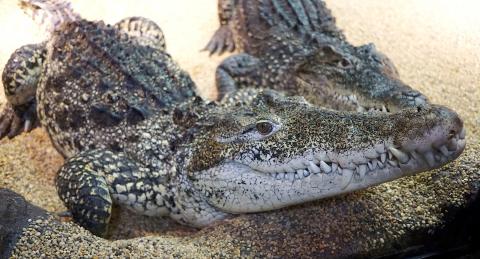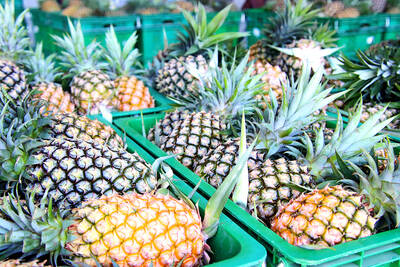Crocodiles have never had a friendly reputation, but they may just have become even scarier. Veterinary scientists have discovered that a surprising number of species are capable of galloping when they reach their top speeds.
Previously it was thought that only a couple of crocodile species were able to use this horse-like gait, but the latest observations show that the ability extends to eight different species. Alligators and caimans, by contrast, can manage only a trot.
Since the gait is shared across many species, the researchers believe galloping may have first emerged in crocodiles’ ancient land-dwelling ancestors, called crocodylomorphs, which were cat-sized creatures with long legs.

Photo: AP
照片:美聯社
John Hutchinson, a specialist in evolutionary biomechanics at the Royal Veterinary College, London, who led the study, said a surprising finding was that despite the different gaits and sizes, almost all the species studied had a top speed of about 18km per hour. “We suspect that bounding and galloping give small crocodiles better acceleration and maneuverability, especially useful for escaping from danger,” he said. “It seems like alligators and caimans stand their ground rather than run away with an extreme gait.”
The researchers found that bigger crocodiles were less likely to gallop, the largest galloping species being a Cuban crocodile, typically measuring more than 2m long. “That’s as big as crocs can get and still bound and gallop,” said Hutchinson. “The Cuban crocs are incredibly active on land and incredibly athletic. This species is notorious for being really aggressive.”
Other, smaller species, were more likely to gallop into the water to escape rather than to chase prey. Hutchinson said galloping appears to have emerged multiple times in evolution in different species, as an energetically efficient way to get around. Some toads and spiders gallop, he said.
The scientists carried out the study at St. Augustine Alligator Farm Zoological Park in Florida, US, where they recorded videos of 42 individuals from 15 species. The creatures were placed at the end of a runway and coaxed to run to the other end. “Every animal it took a different motivation,” said Hutchinson. “Some of them wouldn’t go at all. The caimans and alligators tended to just sit there and hiss and fight.” The findings are published in the journal Scientific Reports.
(The Guardian)
鱷魚從來不曾被人認為友善,不過它們可能比你想像的還要可怕。獸醫科學家近日發現,當鱷魚達到最快速度時,能夠像馬一樣奔馳的種類多到驚人。
人們之前以為,只有少數幾種鱷魚擁有這種像馬般奔馳的步態,然而最新的觀察結果顯示,這種能力出現在多達八種鱷魚身上。相較之下,短吻鱷和凱門鱷頂多只能小跑步。
正因為這種步態同時出現在許多鱷魚種類中,研究人員遂推論「奔馳」的技能可能最初來自於鱷魚的古老陸棲祖先「鱷形超目」。鱷形超目底下的物種大小像貓,且四肢細長。
倫敦皇家獸醫學院的演化生物力學專家約翰‧哈欽森是這篇研究的主持人。他表示,讓人驚訝的發現在於,儘管步伐和體型大小互有差異,但幾乎所有被研究的鱷魚種類最快時速都能達到將近十八公里。哈欽森教授說:「我們猜想,跳躍和奔馳的動作給予小型鱷魚更好的加速能力和機動性,對於逃離危險特別有用。」他補充指出:「看起來短吻鱷和凱門鱷比較傾向於堅守原處,而不是一溜煙地飛快逃跑。」
研究人員發現,較大型的鱷魚比較不太可能奔馳,而在會奔跑的鱷魚種類中,體型最大的是古巴鱷,體長通常超過兩公尺。哈欽森說:「那也就是還能跳能跑的鱷魚可以長到的最大尺寸了。」他補充說:「古巴鱷在陸地上的活躍程度讓人難以置信,而且行動敏捷到有點誇張。這種鱷魚攻擊性很強,因此惡名昭彰。」
其他較小的鱷魚種類比較可能會一路奔馳到水裡逃命,而不會死命追趕獵物。哈欽森指出,奔馳的行為似乎在演化史中多次出現於不同物種身上,是一種能量上較有效率的逃跑方式。他表示,有些種類的蟾蜍和蜘蛛也會奔馳。
科學家在美國佛羅里達州的聖奧古斯丁鱷魚農場動物園進行這項研究,他們對十五種鱷魚,共四十二隻個體進行錄影。研究人員將這些動物放在一條跑道的末端,然後哄騙它們跑向另一端。哈欽森指出:「每一隻個體都需要不同的動機。」他表示:「有些鱷魚就是完全不想走。凱門鱷和短吻鱷則比較傾向於坐在原地發出嘶嘶聲互相挑釁,然後打成一團。」這項研究發表於期刊《科學報告》。
(台北時報章厚明譯)

A: Recently, I’ve been seeing mosquitoes flying around in front of my eyes. The doctor said it’s the “flying-mosquito disease.” B: Flying mosquitoes? What a strange name. A: They’re actually called “floaters” in English, meaning floating debris. When fibrous substances in the vitreous body inside the eyeballs increase, floaters can appear in the visual field. B: Oh my goodness. Can you get rid of them? A: According to ophthalmologist Horng Chi-ting’s research, taking the enzymes of certain fruits is likely to help reduce floaters. A: 我最近一直覺得眼前有蚊子飛來飛去,結果醫生說是「飛蚊症」。 B: 飛蚊症?好奇怪的病名。 A: 英文名稱叫「floaters」, 也就是漂浮物的意思。 因為眼球的玻璃體中纖維化物質增多,導致視野出現漂浮物。 B: 天啊!要怎麼把蚊子趕走? A:

Bilingual Story is a fictionalized account. 雙語故事部分內容純屬虛構。 I stand by the Miluo River as dusk falls. The court betrayal is too much. I served Chu with loyalty. I forged alliances and fought corruption. But the whispers of jealous courtiers, the murmurs of treason, spoke louder. The king cast me out. The water looks calm. It promises peace. I step in. The river is cold against my legs. I hear shouts behind me — fishermen calling my name. I keep walking. The calls grow louder, but I do not turn around. The water rises to my chest. It pulls at me. I

In Taiwan, people can use a platform to rent a power washer for a weekend or share unused garage space for someone’s storage needs. These are examples of the sharing economy, a consumption model that has gained widespread adoption worldwide. This approach allows people to rent or share assets like cars, homes or even services, typically through online platforms. This innovative model poses a simple yet powerful question: why purchase infrequently used items when sharing is more practical? By making useful but idle resources accessible, the sharing economy turns them into sustainable opportunities. Internationally, platforms like Airbnb and Uber have popularized

A: What types of fruit enzymes should we take to help reduce eye floaters? B: According to a study published in the “Applied Sciences” journal by Taiwanese ophthalmologist Horng Chi-ting, pineapple, papaya and fig supplements can improve symptoms. A: Pineapples are in season now, so you should munch on more of those to get rid of floaters. B: Not quite. Enzymes can be damaged by our stomach acid if we eat the fruit directly. The doctor says taking fruit enzyme capsules is better for absorption. A: Most importantly, we should reduce our use of personal electronics to prevent floaters from